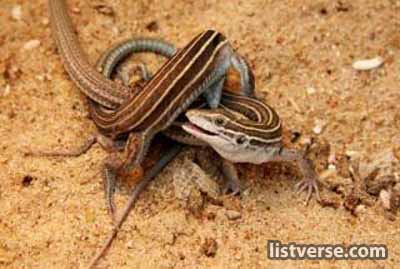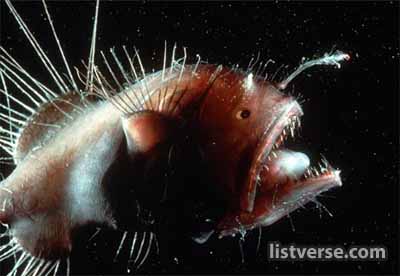Here is a topic about the birds and the bees – as it relates to the animal kingdom. This is a selection of 10 of the most bizarre mating rituals known to man.
10. Red-Sided Garter Snakes

These snakes are small and poisonous, and live in Canada and the Northwestern United States. Their highly unusual mating takes place during an enormous orgy. Hundreds snakes slither together in a large den, eager to copulate. In that pile, one female may have as many as 100 males vying for her. These ‘nesting balls’ grow as large as two feet high. Now and then a female is crushed under the heavy mound.
Interesting Fact: Some male garter snakes are able to release the same scent that females release, causing them to be mounted by hundreds of other snakes. Scientists believe this may be for warmth and protection.
9. Argonaut

Argonauts exhibit extreme sexual dimorphism in size and lifespan. Females grow up to 10 cm and make shells up to 30 cm, while males rarely surpass 2 cm. The males only mate once in their short lifetime. The males lack the dorsal tentacles used by the females to create their eggcases. The males use a modified arm, the hectocotylus, to transfer sperm to the female. For fertilization, the arm is inserted into the female’s pallial cavity, then is detached from the male.
Interesting Fact: Argonauts are capable of altering their color. They can blend in with their surroundings to avoid predators.
8. Whiptail Lizard

The whiptail lizard is an all-female species. It reproduces through a method called parthenogenesis. Each Whiptail lizard has an ovarian cycle of 21 to 28 days. When two are placed in a cage together, they synchronize their cycles so they are opposite. For 10 to 14 days, one of the females will act male, which means she mounts the other. The remaining Whiptail takes the female role by receiving; then they switch roles. This is unusual as neither is truly male. The resulting offspring of this method of mating is a perfect clone of its mother.
Interesting Fact: In the lab, through genetic manipulation, scientists have been able to artifically create true male whiptail lizards.
7. Anglerfish

The Anglerfish has one of the most unique mating methods. When a male is born, it has no digestive system so it needs to find a female (all of which do have digestive systems) quickly. When it finds a suitable female, it latches on to the side of her by biting her and it releases an enzyme that melts her skin causing the two to fuse together. The male then wastes away and the female has a permanent supply of sperm to fertilize her eggs on demand.
Interesting Fact: The anglerfish is a culinary speciality in certain Asian countries. In Japan, each fish sells for as much as $150 USD.
6. Bedbug

Bedbugs mate by “traumatic insemination” – what this means is that the male doesn’t even bother with the female sexual organs – it simply stabs the female with its own sword like sexual organ in any part of her body. Lovely. This form of mating is thought to have evolved as a way for males to overcome female mating resistance.
Interesting Fact: Bedbugs are generally active only at dawn, with a peak attack period about an hour before dawn.
5. Giant Panda

Giant Pandas are famously difficult to get to mate in captivity – at least until some bright spark in China discovered that showing them panda porn seems to help increase their libido! In 1998 the result of showing panda porn lead to the population of pandas in Wolong zoo to more than double.
Interesting Fact: Two of President Theodore Roosevelt’s sons were the first Westerners to shoot a giant panda for sport.
4. Percula Clownfish

The star fish in Finding Nemo is a clownfish. What most people don’t know, is that Nemo was neither a boy nor a girl – s/he was both! Clownfish can change gender! They will normally live together in a small group – the largest is the female, the second largest is the male, and the rest are non-mating males. If the female dies, the largest male will become the female, and the largest of the non-mating males will be promoted to the mating male.
Interesting Fact: Clownfish and damselfish are the only fish that can avoid the potent stings of an anemone.
3. Giraffe

Female giraffes associate in groups of a dozen or so members, occasionally including a few younger males. Males tend to live in “bachelor” herds, with older males often leading solitary lives. Reproduction is polygamous, with a few older males impregnating all the fertile females in a herd. Male giraffes determine female fertility by nudging the females backside until she urinates in his mouth – he uses the taste to determine whether the female is in heat.
Interesting Fact: Giraffes have extremely long tongues – often up to 45cm.
2. Porcupine

Female porcupines are only interested in sex for 8-12 hours per year. Interested males will stand on their hind legs and spray a female with urine. If she is ready and interested, she will expose her quill-less belly to the male and they will mate until they are both exhausted. if the male tires before the female, she will seek another male to take his place. If a female is not ready or interested in a male, she will make a screaming noise and shake the males urine off herself.
Interesting Fact: Porcupine meat is valued as a food for humans in parts of Africa, Italy, and Vietnam.
1. The Spotted Hyena

Unlike most other hyenas, the female spotted hyena has a pseudo-penis (enlarged clitoris). Female hyenas give birth, copulate, and urinate through their protruding genitalia, which stretches to allow the male penis to enter for copulation, and it also stretches during birth. The anatomical position of the genitalia gives females total sexual control over who is allowed to mate with them. The female is also larger than the male. In the spotted hyena family, the female really does wear the pants.
Interesting Fact: Hyenas, unlike other canids, do not raise their leg when urinating.
Tuesday, November 16, 2010
Top 10 Bizarre Animal Mating Rituals
Subscribe to:
Post Comments (Atom)

No comments:
Post a Comment